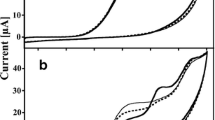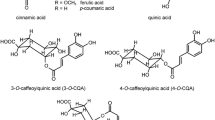Abstract
Brazil is the largest producer and exporter of coffee in the world; the beverage is recognized as the main source of chlorogenic acids (CA), which have beneficial effects on human health. In this study, a multivariate optimization of extraction conditions was performed, aiming to maximize the extraction of chlorogenic acids isomers (3-caffeoylquinic acid (3-CQA), 4-caffeoylquinic acid (4-CQA), 5-caffeoylquinic acid (5-CQA), 3.4-dicaffeoylquinic acid (3.4-DQA), 3.5-dicaffeoylquinic acid (3.5-DQA), and 4.5-dicaffeoylquinic acid (4.5-DQA)). The optimal extraction condition was obtained using ethanol and water in the proportions of 32.4:67.6, and a 22-min extraction period, resulting in a fast, precise, accurate, and cost-effective method, with low toxic waste generation. Optimized extraction conditions were employed to investigate the CA content in different types of ground roasted coffee available on the market (traditional, extra strong, gourmet, decaffeinated, and organic). Results showed that, although these products are differentiated by their value of trade, no difference in the chlorogenic acids content was found.


Similar content being viewed by others
References
ABIC Associação Brasileira da Indústria de Café no Brasil (2015) ABIC: Estatíticas - Indicadores da Indústria de Café no Brasil http://www.abic.com.br/publique/cgi/cgilua.exe/sys/start.htm?sid=61#5103 Accessed 24 Oct 2016
Alves ST, Dias RCE, Benassi MT (2006) Metodologia para análise simultânea de ácido nicotínico, trigonelina, ácido clorogênico e cafeína em café torrado por cromatografia líquida de alta eficiência. Química Nov. 29(6):1164–1168
Babova O, Occhipinti MME (2016) Chemical partitioning and antioxidant capacity of green coffee (Coffea arabica and Coffea canephora) of different geographical origin. Phytochemistry 123:33–39
BRASIL ANVISA - Resolução 899, de 29 de maio de 2003 (2003) http://www.anvisa.gov.br/legis/resol/2003/re/899_03re.htm. Accessed 21 June, 2016
Bravo L, Goya L, Lecumberri E (2007) LC/MS characterization of phenolic constituents of mate (Ilex paraguariensis, St. Hil.) and its antioxidant activity compared to commonly consumed beverages. Food Res Int 40:393–405
Breitkreitz MC, Jardim ICSF, Bruns RE (2009) Combined column-mobile phase mixture statistical design optimization of high-performance liquid chromatographic analysis of multicomponent systems. J Chromatogr A 1216:1439–1449
Cardozo Junior EL, Ferrarese-Filho O, Cardozo Filho L, Ferrarese MLL, Donaduzzi CM, Sturion JÁ (2007) Methylxanthines and phenolic compounds in mate (Ilex paraguariensis St. Hil.) progenies grown in Brazil. J Food Compos Anal 20:553–558
Cichoki M, Blumczynska J, Baer-Bubowska W (2010) Naturally occurring phenolic acids inhibit 12-O-tetradecanoylphorbol-13-acetate induced NF-kB, iNOS and COX-2 activation in mouse epidermis. Toxicology 268:118–124
Clifford MN (1999) Chlorogenic acids and other cinnamates—nature, occurrence and dietary burden. J Sci Food Agr 79:362–372
Craig AN, Fields C, Liang N, Kitts D, Erickson A (2016) Performance review of a fast HPLC-UV method for the quantification of chlorogenic acids in green coffee bean extracts. Talanta 154:481–485
Da Silveira TFF et al (2016) Phenolic compounds from yerba mate based beverages—a multivariate optimisation. Food Chem 190:1159–1167
Derringer G, Suich R (1980) Simultaneous optimization of several response variables. J Qual Technol 12:214
Duarte GS, Farah A (2011) Effect of simultaneous consumption of milk and coffee on chlorogenic Acids’ bioavailability in humans. J Agric Food Chem 59:7925–7931
FAO (2015) Statistical Pocketbook: Coffee.
Farah A, Donangelo CM (2006) Phenolic compounds in coffee. Braz J Plant Physiol 18:23–36
Farah A, Monteiro MC, Trugo LC (2005) Distribuição de ácidos clorogênicos nos principais defeitos do café. In: Annals of the IV Simpósio de PNP&D Embrapa Café. Londrina, P.R., Brazil
Filip R, López P, Giberti G, Coussio J, Ferraro G (2001) Phenolic compounds in seven South American Ilex species. Fitoterapia 72:774–778
Fu H, Li W, Lao Y, Luo J, Lee NTK, Kan KW, Tsang HW, Tsim KWK (2006) Bis(7)-tacrine attenuates beta amyloid-induced neuronal apoptosis by regulating L-type calcium channels. J Neurochem 98:1400–1410
Gordon MH, Whishart K (2010) Efects of chlorogenic acid and bovine serum albumin on the oxidative stability of low density lipoprotein in vitro. J Agric Food Chem 58:5828–5833
Gugliucci A, Bastos DHH (2009) Chlorogenic acid protects paraoxonase 1 activity in high density lipoprotein from inactivation caused by physiological concentrations of hypochlorite. Fitoterapia 80:138–142
Halliwell, B.(2005) Free radicals and others reactive species in disease. National University of Singapura
Hoelzl C, Kasmuller S, Wagner K, Elbling L, Huber W, Kager N, Ferk F, Ehrlich V, Nersensyan A, Neubauer O, Desmarchelier A, Marin-Kuan M, Delatour T, Verguet C, Bezençon C, Bessons A, Grathwohl D, Simic T, Kundis M, Schilter B, Cavin C (2010) Instant coffee with high chlorogenic acid levels protect humans against oxidative damage of macromulecules. Mol. Nutr. Foods Res 54:1–12
Huxley R, Lee CMY, Barzi F, Timmermeister L, Czernichow S, Perkivic V, Grobbee DE, Batty D, Woodward M (2009) Coffee, decaffeinated coffee, and tea consumption in relation to incident type 2 diabetes mellitus. Arch Intern Med 22:2053–2063
ICO (2016) Coffee Trade Stats: Brazil https://infogr.am/brazil-4166040754 Accessed 24 Oct 2016
IUPAC Technical Report (2002) Harmonized guidelines for single laboratory validation of methods of analysis. Pure Appl Chem 74:835–855
Jeszka-Skowron M, Zgoła-Grześkowiak A (2014) Analysis of antioxidant activity, chlorogenic acid, and rutin content of Camellia sinensis infusions using response surface methodology optimization. Food Anal Methods 7:2033–2041
Kelly BL, Ferreira A (2006) Beta-amyloid-induced dynamin 1 degradation is mediated by N-methyl-D-aspartate receptors in hippocampal neurons. J Biol Chem 281:28079–28080
Kempf K, Herder C, Erlund I, Kolb H, Martin S, Carstensen M, Koenig W, Sundvall J, Bidel S, Kuha S, Tuomilehto J (2010) Effects of coffee consumption on subclinical inflammation and other risk factors for type 2 diabetes: a clinical trial. Am J Clin Nutr 7:950–957
Kitzberger CSG, Scholz MBS, Benassi MT (2014) Bioactive compounds content in roasted coffee from traditional and modern Coffea arabica cultivars grown under the same edapho-climatic conditions. Food Res Inter 61:61–66
Lee CW, Won TJ, Kim HR, Lee D, Hwang KW, Park S (2011) Protective effect of chlorogenic acid against A-beta-induced neurotoxicity. Biomol Ther 19:181–186
Lin J, Liu S, Hu C, Shyu Y, Hsu C, Yang D (2015) Effects of roasting temperature and duration on fatty acid composition, phenolic composition, Maillard reaction degree and antioxidant attribute. Food Chem 190:520–528
Marques VX, Farah A (2010) Urinary excretion of chlorogenic acids and metabolites in humans after green mate (I. paraguariensis) consumption. FASEB J 24:922.1
Monteiro MC, Trugo LC (2005) Determinação de compostos bioativos em amostras comerciais de café torrado. Química Nov. 28:637–641
Nardini M, D’aquin M, Tomassi G, Gentili V, Di Felice M, Scaccini C (1995) Inhibition of human low-density lipoprotein oxidation by caffeic acid and other hydroxycinnamic acid derivatives. Free Radic Biol Med 19:541–552
Neto BB, Scarminio IE, Bruns RE (2010) Como fazer experimentos: aplicações na ciência e na indústria. 4. ed. Porto Alegre: Bookman.
Pietta PG (2000) Flavonoids as antioxidants. J Nat Prod 63:1.035–1.042
Risso EM, Peres RG, Amaya FJ (2007) Determination of phenolic acids in coffee by micellar electro kinetic chromatography. Food Chem 105:1578–1582
Santos MH, Batista BL, Duarte SMS, Abreu CMP, Gouvea CMCP (2007) Influência do processamento e da torrefação sobre a atividade antioxidante do café. Química Nov. 30:604–610
Schaefer S, Baum M, Eisenbrand G, Janzowski C (2006) Modulation of oxidative cell damage by reconstituted mixtures of phenolic apple juice extracts in human colon cell lines. Mol Nutr Foods Res 50:413–417
Tang KSC, Konczak I, Zhao J (2015) Identification and quantification of phenolics in Australian native mint. Food Chem 192:698–705
Trugo LC, Macrae R (1984) Chlorogenic acid composition of instant coffees. Analyst 109:263–266
Author information
Authors and Affiliations
Corresponding author
Ethics declarations
This study was funded by Coordination for the Improvement of Higher Education Personnel (CAPES, 1267386) and São Paulo Research Foundation (cases no. 10/50876-1, 11/10671-4, 12/12565-0). The author Adriana Dillenburg Meinhart has received research grants from CAPES (PNPD, 1267386). The authors thank the Espaço da Escrita at the University of Campinas/SP, for the translation work.
Conflict of Interest
Author Adriana Dillenburg Meinhart declares that she has no conflict of interest. Tayse Ferreira Ferreira da Silveira declares that she has no conflict of interest. Rosicleia Araújo Silva declares that she has no conflict of interest. Fernanda Mateus Damin declares that she has no conflict of interest. Roy Edward Bruns declares that he has no conflict of interest. Helena Teixeira Godoy declares that she has no conflict of interest.
Ethical Approval
This article does not contain any studies with human participants or animals performed by any of the authors.
Informed consent
Not applicable.
Rights and permissions
About this article
Cite this article
Meinhart, A.D., da Silveira, T.F.F., Silva, R.A. et al. Multivariate Optimization of Chlorogenic Acid Extraction From Brazilian Coffee. Food Anal. Methods 10, 2943–2951 (2017). https://doi.org/10.1007/s12161-017-0847-9
Received:
Accepted:
Published:
Issue Date:
DOI: https://doi.org/10.1007/s12161-017-0847-9




